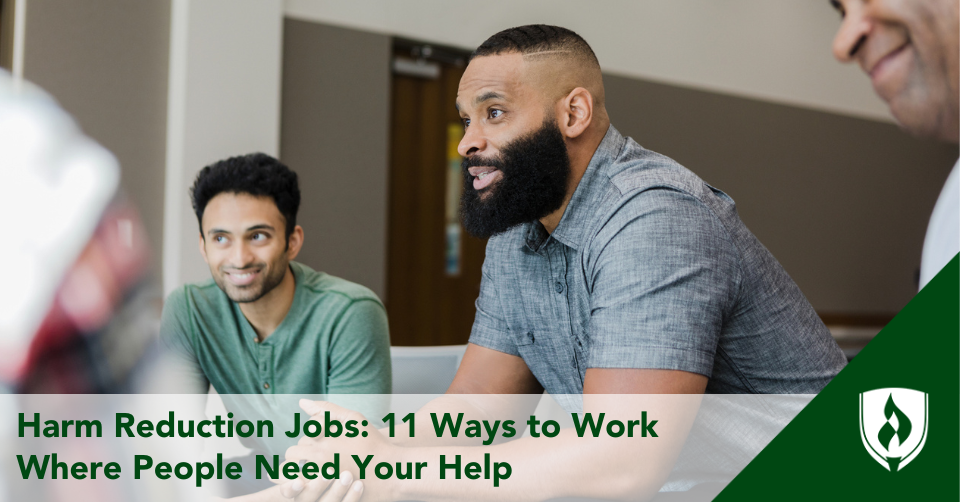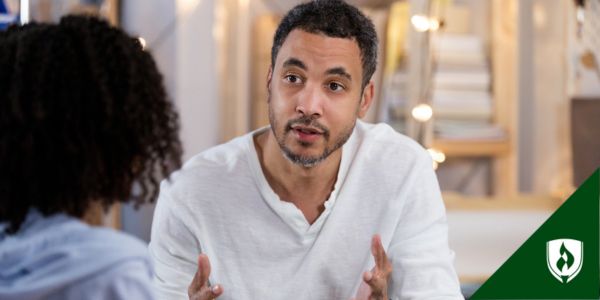
The influence that harm reduction can have on an individual – and by extension – a family or community, is both profound and lifesaving. Let's paint a picture.
Drug overdose deaths in the United States have increased 50% since 2019 – with each year claiming over 100,000 victims (and climbing each year).1 To put that into perspective – that's nearly 275 preventable deaths every day.
And it's wild to note that in 2010, the Center for Disease Control (CDC) foundation reported that the number of drug overdose deaths in America was 38,329.2 If you compare that to statistics for 2022, that’s increase of over 163%. Overdose deaths are on the rise.
This is why harm reduction jobs are so important and necessary.
If you've ever lost someone to a preventable death or felt the pull to make a difference in the lives of those facing addiction, pursuing one of many harm reduction jobs can help you help others.
Whether you're captivated by the intricacies of health science or the hands-on, people-centered approach of human services, we'll explore how both avenues can pave the way for you to become a catalyst of support, understanding and change in the lives of those who need it most as a harm reduction worker.
Understanding harm reduction
Harm reduction is an evidence-based strategy crucial for interacting with individuals who use addictive substances. It empowers them to shift away from life-threatening situations. Harm reduction is a fundamental cornerstone within the U.S. Department of Health and Human Services' Overdose Prevention Strategy.3
Harm reduction is more than just a methodology – it's a philosophy. When you are trapped in addiction, homelessness or high-risk situations, things are complicated. Harm reduction acknowledges the many factors at play and works to minimize the negative consequences of these circumstances.
Some protective services and providers withhold their help until an individual can “get clean.” But harm reduction services wade in to help people right now, where they’re at.
It’s about finding practical ways to make drug use safer, and it encompasses practical strategies to minimize the adverse outcomes connected to drug use. But it's also an ethical movement that focuses on care, fairness and treating people as valuable human beings no matter what their situations are. It's both a set of ideas for reducing harm and a movement advocating for social justice.3
This movement is also about reducing harm and stigma linked to drug use through public health interventions, advocacy and education.3 It starts with recognizing the basic right of all individuals to safety and dignity. And perhaps most importantly, it avoids viewing drug use as a moral failing.
Here are some examples of harm reduction services, products and interventions:4
- Helmets
- Speed limits
- Housing
- Methadone
- Free-use clinics/ Overdose prevention sites
- Syringe exchange
- Face masks (and other PPE)
- Sunscreen
- Naloxone distribution programs
- Peer programs
- Medication-assisted treatment
You see, harm reduction is everywhere in our society. From a simple tool to a complex organization. Harm reduction offers support to individuals who are in danger. It's a testament to the fact that everyone deserves care and safety.
Pathway 1: Embracing harm reduction through health science
If you're drawn to the scientific aspects of addressing public health challenges, pursuing a degree in health science could potentially be your gateway to harm reduction work.
Health science professionals play a critical role in designing and implementing interventions that directly impact the well-being of individuals and communities.
With a degree in health science, you can branch into public or community health roles that allow you to combine scientific knowledge with empathy-driven strategies and drive change.
Harm reduction career opportunities for health science graduates
Health sciences graduates possess a strong foundation in healthcare and public health, which makes them well-suited for a range of harm reduction roles.
Here are some professions that health sciences graduates could possibly pursue in relation to harm reduction framework and practice:
1. Public health educator
Design and implement educational campaigns to raise awareness about harm reduction practices, drug safety and safer behaviors. Your knowledge of health promotion will be valuable in reaching and influencing diverse communities.
2. Health program coordinator
Craft and oversee harm reduction initiatives within healthcare environments or community entities. Your grasp of health systems and policies could aid in formulating impactful interventions.
3. Health policy analyst
Promote evidence-based harm reduction policies at the local, state, and national levels, leveraging your comprehensive grasp of health systems and policies to drive impactful and constructive change.
4. Community health advocate
Community health workers promote harm reduction practices, focusing on access to clean needles, overdose prevention and safe disposal of drug-related paraphernalia. Community health workers serve as liaisons between communities and healthcare services. They offer health education, connect people who are in need of care and resources and advocate for improved health outcomes.
5. Health researcher
Conduct studies on the effectiveness of harm reduction interventions and contribute to evidence-based approaches for addressing drug addiction and related health issues.
6. Public health consultant
Provide expertise to top companies and government agencies on implementing harm reduction strategies and interventions, ensuring alignment with public health goals.
7. Health clinic manager
Oversee clinics or health centers that offer harm reduction services, ensuring that individuals receive comprehensive care and support.
Pathway 2: Engaging with harm reduction through human services
If you gravitate more toward the empathy and person-centric aspects of harm reduction, you might want to consider a degree in human services.
Human services professionals provide support, advocacy and resources to vulnerable populations. By pursuing this field, you can implement principles of harm reduction or seek out organizations that embody harm reduction strategies in their work.
Career opportunities for human services graduates
A human services degree could open doors to a wide array of professions that intersect with harm reduction, offering meaningful opportunities to support and empower individuals facing challenges.5 Some of the roles that could align with a human services degree in the realm of harm reduction include:
1. Community support worker
For individuals drawn to a more hands-on approach in human services, the role of a Community Support Worker is a significant avenue within harm reduction. These professionals work directly with individuals facing drug addiction, homelessness or other challenging circumstances. They provide practical assistance, emotional support and resource referrals to help individuals regain control of their lives. Community support workers often collaborate with multidisciplinary teams to develop comprehensive care plans tailored to the unique needs of each person.
2. Outreach coordinator
Another compelling role within harm reduction that aligns with public health is that of an Outreach Coordinator. These professionals bridge the gap between vulnerable populations and essential services.
Outreach coordinators organize educational campaigns, distribute harm reduction supplies (such as clean needles and safe injection kits) and facilitate access to healthcare, shelter and counseling. This role involves community engagement and forming meaningful connections with individuals who require support.
3. Shelter manager
If you're passionate about providing homeless services, managing shelters allows you to create safe environments while also providing harm reduction resources and support to those staying at the shelter.
Many shelter organizations and positions incorporate harm reduction in their structure. You could choose an employer who does so, or you could also advocate for more harm reduction in places that do not yet embrace this model.
4. Youth advocate
Many non-profit organizations specifically target youth. A youth advocate works with at-risk youth to help them find the resources they need and guide them toward safer choices. Harm reduction principles play a huge role here.
Your human services expertise will be instrumental in offering guidance, mentorship and resources to empower these young individuals.
Where are harm reduction workers needed most?
Certainly, harm reduction workers are needed in large metro areas due to their higher population density, but the need extends far beyond urban centers. If you consider the magnitude of the ongoing opioid crisis, you’ll see that harm reduction workers could save lives in many places.
Communities of all sizes grapple with drug addiction, homelessness and unsafe situations.
Harm reduction and you
Harm reduction beckons to those who want to be catalysts of positive change. As you contemplate your role in shaping a safer and more compassionate society, consider the potential that lies within a health science or human services education.
Through a select health science degree, you can design and implement interventions that directly impact the lived experience and well-being of individuals and communities.
With a degree in human services, you'll be introduced to basic concepts of psychology, sociology, counseling, crisis intervention, case management, and community and service networking that can align with harm reduction, further empowering you to work with vulnerable populations.
Ultimately, the choice is yours! If you're curious about the health science route, read our article, " What Can You Do With a Public Health Degree? Exploring Your Options."
Or if you're interested in learning more about the role and responsibilities that human services professionals have, read our article, " What Is Human Services? Explaining This Caring Career Field."
Related Articles:
1E. D. Gumas, J C Baumgartner. The Commonwealth Fund. U.S. Overdose Deaths Remain Higher Than in Other Countries — How Harm-Reduction Programs Could Help. Date accessed: 8/25/23. https://www.commonwealthfund.org/blog/2023/us-overdose-deaths-remain-higher-other-countries-how-harm-reduction-programs-could-help
2Slavova S, O'Brien DB, Creppage K, Dao D, Fondario A, Haile E, Hume B, Largo TW, Nguyen C, Sabel JC, Wright D; Council of State and Territorial Epidemiologists Overdose Subcommittee. Drug Overdose Deaths: Let's Get Specific. Date accessed 8/26/23 https://www.ncbi.nlm.nih.gov/pmc/articles/PMC4547584/.
3DrugFreeCT. Examples of Harm Reduction. Date accessed 8/24/23. https://www.drugfreect.org/harm-reduction/
4Drug Free CT, Examples of Harm Reduction. Wheeler Connecticut Clearing House. Date accessed 8/24/23. https://www.drugfreect.org/harm-reduction/
5Rasmussen University's Human Services Associate's and Bachelor's degrees are not designed to meet, and do not meet, the educational requirements for professional licensure as a therapist, counselor, social worker, psychologist or other similar licensed careers, in any state. For further information on professional licensing requirements, please contact the appropriate board or agency in your state of residence.




